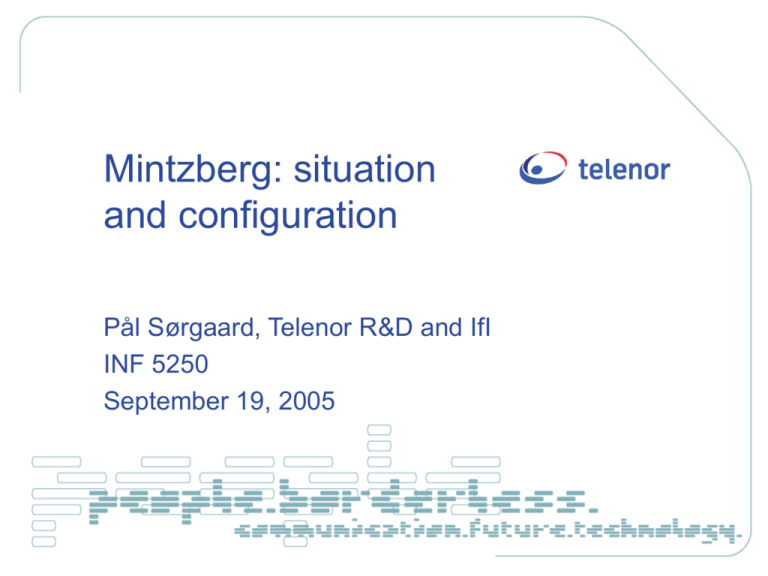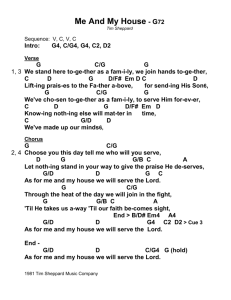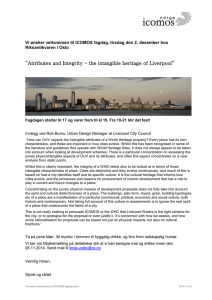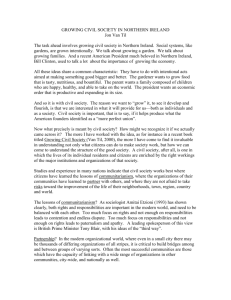Mintzberg: situation and configuration
advertisement

Mintzberg: situation and configuration Pål Sørgaard, Telenor R&D and IfI INF 5250 September 19, 2005 Situational factors of organisations (ch 6) Age and size The technical system used in the operating core Environment (stability, complexity, diversity, hostility) Power relationships In the group task: determine these factors for your case organisation! Test the hypotheses in your case organisation! 19 September, 2005 Pål Sørgaard, R&D 2 Relations between design parameters and with the situation We have worked through 9 design parameters These cannot be combined arbitrarily There are some combinations that are really consistent: these are called configurations Effective structuring requires a fit between situation and design parameters (congruence) Today: cover situational factors, hypotheses about congruence and configuration, and two “basic” configurations 19 September, 2005 Pål Sørgaard, R&D 3 Age and size hypotheses 1. Older organisations tend to rely more on formalisation of behaviour – They’ve seen it all before 2. The structure of the organisation tends to reflect the age of its industry 3. Larger organisations are more elaborate: more specialised tasks, more differentiated units, more developed administrative components 4. Larger organisations have larger units 5. Larger organisations have more formalised behaviour 19 September, 2005 Pål Sørgaard, R&D 4 Technical system in the operating core Woodward’s research on – unit production – mass production – process production (high degree of automation) Mass production, boring jobs, conflict, hostility, suspicion, focus on control Automation (IT!) leads to dramatic reduction on the number of unskilled operators in production – – – – Machines do their jobs without control Hordes of specialists needed Change in mix of people and jobs, new culture Different challenges for management 19 September, 2005 Pål Sørgaard, R&D 5 Technical system hypotheses 6. A more regulating technical systems leads to more formalisation and more bureaucratic structure of the operating core – Remember: this is from the 80ies. Still a lot of manual work being controlled by elaborate technical systems 7. A more sophisticated technical systems requires a more elaborate nonoperating structure (IT/Telenor) 8. Automation of the operating core transforms a bureaucratic administrative structure into an organic one – Less traditional industry, more knowledge industry, especially in high-cost economies 19 September, 2005 Pål Sørgaard, R&D 6 Environment Stability: stable vs dynamic (unpredictable) Complexity: simple vs complex, p 136 Market diversity: integrated vs diversified Hostility: munificent (friendly) vs hostile Telenor example – From stable to dynamic – From quite simple to increasing complexity – From two integrated services in one market to increased diversification and many markets – From monopoly to competition and regulation 19 September, 2005 Pål Sørgaard, R&D 7 Environment hypotheses 9. A more dynamic environment requires more dynamic structure 10. A more complex environment requires more decentralised structure 11. Diversified markets generally lead to split into market-based units 12. Extreme hostility in the environment leads to (temporary) centralisation 13. A mixed environment encourages selective decentralisation 19 September, 2005 Pål Sørgaard, R&D 8 Type of organisation and environment (p 144) stable dynamic Complex Decentralised Bureaucratic (standardisation of skills) Decentralised Organic (mutual adjustment) Simple Centralised Bureaucratic (standardisation of work processes) Centralised Organic (direct supervision) 19 September, 2005 Pål Sørgaard, R&D 9 Power issues External control – owners – politicians – regulation Personal ambitions – at different positions in the organisation Internal power struggles 19 September, 2005 Pål Sørgaard, R&D 10 Power hypotheses 14. External control drives centralisation and formalisation 15. Power needs of groups favour centralisation, to themselves … 16. There is fashion and fad in the way organisations are structured, sometimes resulting in inappropriate structures 19 September, 2005 Pål Sørgaard, R&D 11 Overview of configurations (p 153) Structural configuration Prime coordinating mechanism Key part of organisation Type of decentralisation Simple structure Direct supervision Strategic apex Vertical and horizontal centralisation Machine bureaucracy Standardisation of work processes Technostructure Limited horizontal decentralisation Professional bureaucracy Standardisation of skills Operating core Vertical and horizontal decentralisation Divisionalised form Standardisation of outputs Middle line Limited vertical decentralisation Adhocracy Mutual adjustment Support staff Selective decentralisation 19 September, 2005 Pål Sørgaard, R&D 12 An “evolutionary” interpretation To a large extent organisations compete (companies) As the economy develops, new environmental challenges emerge (e.g. use of IT) Some organisation try new structures to cope better with the challenges Those that succeed, tend to win in the competition Some solutions settle as types/configurations Thus, in an evolving economy, it is no surprise that we over time have an increasing set of typical configurations 19 September, 2005 Pål Sørgaard, R&D 13 The simple structure (ch 8) Characteristics – – – – prime coordinating mechanism: direct supervision key part: strategic apex (the boss) main design parameters: centralisation, organic structure situational factors: young, small, nonsophisticated technical system, simple, dynamic environment, possible extreme hostility or strong power needs of top manager, not fashionable Typical example: the entrepreneurial firm – normally a boss and some employees (operating core) Under extreme conditions other organisations revert to the simple structure 19 September, 2005 Pål Sørgaard, R&D 14 Variants and hybrids The simplest structure (more mutual adjustment) The crisis organisation (temporary) The autocratic organisation (dictatorship) The charismatic organisation 19 September, 2005 Pål Sørgaard, R&D 15 Important features Flexible and dynamic, no bureaucracy Risky (depends on one person) Has a sense of mission, many people like them! Often a stage in a more mature organisation’s life – It’s very hard to grow large with a simple structure The transition from simple structure to other configurations can be difficult 19 September, 2005 Pål Sørgaard, R&D 16 The machine bureaucracy (ch 9) Characteristics – prime coordinating mechanism: standardisation of work processes – key part: technostructure – main design parameters: behaviour formalisation, vertical and horizontal job specialisation, usually functional grouping, large operating-unit size, vertical centralisation and limited horizontal decentralisation, action planning – situational factors: old, large, regulating, nonautomated technical system, simple and stable environment, external control, not fashionable 19 September, 2005 Pål Sørgaard, R&D 17 The organisation as a programmed machine The operating core is the processor The technostructure does the programming Low-level programming where assumptions are hardcoded into the design – equipment – job descriptions The focus is efficiency and control Weber’s ideal Some remaining cases – The Norway Post, Oslo sporveier, SAS, traditional mass production, classical bureaucracies such as the Tax Administration, National Insurance Scheme 19 September, 2005 Pål Sørgaard, R&D 18 Max Weber 1864–1920 The decisive reason for the advance of bureaucratic organisation has always been its purely technical superiority over any other form of organization. The fully developed bureaucratic mechanism compares with other organizations exactly as does the machine with the non-mechanical modes of production. Precision, speed, unambiguity, knowledge of the files, continuity, discretion, unity, strict subordination, reduction of friction and of material and personal costs — these are raised to the optimum point in the strictly bureaucratic organization (p 176 in Structure in Fives) 19 September, 2005 Pål Sørgaard, R&D 19 The control issue Rules, regulations, formal communication, formal chain of authority: predictability Attempts are made to eliminate all uncertainties, so that the organisation can run smoothly, uninterruptedly By virtue of its design, the structure is ridden with conflict; the control system is required to contain it – – – – separation of planning and doing jobs with little satisfaction difficult to get heard vulnerable to disobedience Conflicts are not resolved, but bottled up 19 September, 2005 Pål Sørgaard, R&D 20 Challenges for the machine bureaucracy Work of complex environments cannot be rationalised into simple tasks The work of dynamic environments cannot be predicted and made repetitive Does not cope well with full automation of the operating core Behaviour and lack of mutual adjustment (govt) Human problems Split strategy formulation and strategy implementation – Assumes full information – Assumes enough stability so that strategies remain relevant during implementation 19 September, 2005 Pål Sørgaard, R&D 21 Future of the configuration Will become less common, especially in rich, developed countries Will remain superior in mass production involving manual work Loses (has lost?) its role as the main type of organisation, as the source for general principles about organising May still thrive in contexts were external control and predictability is given top priority – this ought to be a dilemma for politicians 19 September, 2005 Pål Sørgaard, R&D 22






